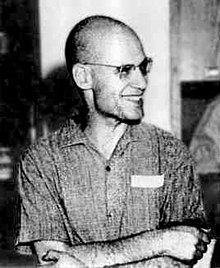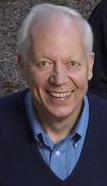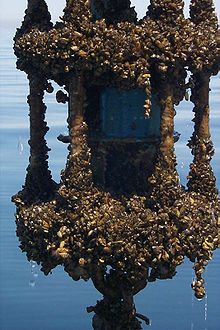Per Enflo: Difference between revisions
→Human evolution: Fix broken reference |
|||
| Line 162: | Line 162: | ||
the [[Neanderthal extinction hypotheses|extinction of Neanderthals]] could have happened simply as waves of modern humans entered Europe. |
the [[Neanderthal extinction hypotheses|extinction of Neanderthals]] could have happened simply as waves of modern humans entered Europe. |
||
Neanderthals and modern humans coexisted in Europe for several thousand years, but the duration of this period is uncertain.<ref>Mellars, P. 2006. A new radiocarbon revolution and the dispersal of modern humans in Eurasia. ''Nature'' 439:931–935.</ref> Modern humans may have first migrated to Europe 40–43,000 years ago |
Neanderthals and modern humans coexisted in Europe for several thousand years, but the duration of this period is uncertain.<ref>Mellars, P. 2006. A new radiocarbon revolution and the dispersal of modern humans in Eurasia. ''Nature'' 439:931–935.</ref> Modern humans may have first migrated to Europe 40–43,000 years ago.<ref name=banks>{{cite journal|last=Banks|first=William E.|coauthors=Francesco d'Errico, A. Townsend Peterson, Masa Kageyama, Adriana Sima, Maria-Fernanda Sánchez-Goñi|date=24 December 2008|title=Neanderthal Extinction by Competitive Exclusion|journal=PLoS ONE|publisher=Public Library of Science|volume=3|issue=12|pages=e3972|issn=1932-6203|url=http://www.plosone.org/article/info:doi%2F10.1371%2Fjournal.pone.0003972}}</ref>. Neanderthals may have lived as recently as 24,000 years ago in [[Refugium (population biology)|refugia]] on the south coast of the Iberian peninsula such as [[Gorham's Cave]].<ref>{{cite news|url=http://news.bbc.co.uk/1/hi/5343266.stm?lsm|title=Neanderthals' 'last rock refuge'|last=Rincon|first=Paul|date=13 September 2006|work=BBC News|accessdate=2009-10-11}}</ref><ref>Finlayson, C., F. G. Pacheco, J. Rodriguez-Vidal, D. A. Fa, J. M. G. Lopez, A. S. Perez, G. Finlayson, E. Allue, J. B. Preysler, I. Caceres, J. S. Carrion, Y. F. Jalvo, C. P. Gleed-Owen, F. J. J. Espejo, P. Lopez, J. A. L. Saez, J. A. R. Cantal, A. S. Marco, F. G. Guzman, K. Brown, N. Fuentes, C. A. Valarino, A. Villalpando, C. B. Stringer, F. M. Ruiz, and T. Sakamoto. 2006. Late survival of Neanderthals at the southernmost extreme of Europe. ''Nature'' advanced online publication.</ref> Inter-stratification of Neanderthal and modern human remains has been suggested,<ref>Gravina, B., P. Mellars, and C. B. Ramsey. 2005. Radiocarbon dating of interstratified Neanderthal and early modern human occupations at the Chatelperronian type-site. ''Nature'' 438:51-56.</ref> but is disputed.<ref>{{cite journal|last=Zilhão|first=João|coauthors=Francesco d’Errico, Jean-Guillaume Bordes, Arnaud Lenoble, Jean-Pierre Texier, and Jean-Philippe Rigaud|date=2006|title=Analysis of Aurignacian interstratification at the Châtelperronian-type site and implications for the behavioral modernity of Neandertals|journal=PNAS|volume=103|issue=33|pages=12643–12648|url=http://www.pnas.org/content/103/33/12643.full}}</ref> |
||
[[Image:Zebra mussel GLERL 3.jpg|thumb|Enflo has [[mathematical biology|analyzed]] the [[population ecology]] of [[Zebra mussel]]s, which have expanded in the [[Great Lakes]].]] |
[[Image:Zebra mussel GLERL 3.jpg|thumb|Enflo has [[mathematical biology|analyzed]] the [[population ecology]] of [[Zebra mussel]]s, which have expanded in the [[Great Lakes]].]] |
||
Revision as of 00:57, 28 March 2010
Per Enflo | |
|---|---|
| Born | 1944 |
| Alma mater | Stockholm University |
| Known for | Approximation problem Schauder basis Hilbert's fifth problem (infinite-dimensional) uniformly convex renorms of superreflexive Banach spaces embedding metric spaces (unbounded distortion of cube) "Concentration" of polynomials at low degree Invariant subspace problem |
| Awards | Mazur's "live goose" for solving "Scottish Book" Problem 153 |
| Scientific career | |
| Fields | Functional analysis Operator theory Analytic number theory |
| Institutions | University of California, Berkeley Stanford University École Polytechnique, Paris The Royal Institute of Technology, Stockholm Kent State University |
| Doctoral advisor | Hans Rådstrom |
| Doctoral students | Nilson Bernardes Miguel Lacruz Jan-Ove Larsson Marie Lövblom Bruce Reznick Anthony Weston |
Per H. Enflo (born 1944) is a mathematician who has solved fundamental problems in functional analysis. Three of these problems had been open for more than forty years:
- The basis problem and the approximation problem[1] and later
- the invariant subspace problem for Banach spaces.[2]
In solving these problems, Enflo developed new techniques which were then used by other researchers in functional analysis and operator theory for years. Some of Enflo's research has been important also in other mathematical fields, such as number theory, and in computer science, especially computer algebra and approximation algorithms.
Enflo was born in Stockholm, Sweden in 1944. Enflo works at Kent State University, where he holds the title of University Professor. Enflo has earlier held positions at the University of California, Berkeley, Stanford University, École Polytechnique, (Paris) and The Royal Institute of Technology, Stockholm.
Enflo is also a concert pianist.
Enflo's contributions to functional analysis and operator theory
In mathematics, Functional analysis is concerned with the study of vector spaces and operators acting upon them. It has its historical roots in the study of functional spaces, in particular transformations of functions, such as the Fourier transform, as well as in the study of differential and integral equations. This usage of the word functional goes back to the calculus of variations, implying a function whose argument is a function. Its use in general has been attributed to Italian mathematician and physicist Vito Volterra and its founding is largely attributed to a group of Polish mathematicians around Stefan Banach. In the modern view, functional analysis is seen as the study of vector spaces endowed with a topology, in particular infinite dimensional spaces. In contrast, linear algebra deals mostly with finite dimensional spaces, or does not use topology. An important part of functional analysis is the extension of the theory of measure, integration, and probability to infinite dimensional spaces, also known as infinite dimensional analysis.
The basic and historically first class of spaces studied in functional analysis are complete normed vector spaces over the real or complex numbers. Such spaces are called Banach spaces. An important example is a Hilbert space, where the norm arises from an inner product. These spaces are of fundamental importance in many areas, including the mathematical formulation of quantum mechanics.
More generally, functional analysis includes the study of Fréchet spaces and other topological vector spaces not endowed with a norm. An important object of study in functional analysis are the continuous linear operators defined on Banach and Hilbert spaces.
Hilbert's fifth problem and embeddings
At Stockholm University, Hans Rådström suggested that Enflo consider Hilbert's fifth problem in the spirit of functional analysis.[3] In two years, 1969-1970, Enflo published five papers on Hilbert's fifth problem; these papers are collected in Enflo (1970), along with a short summary. Some of the results of the these papers are described in Enflo (1976) and in the last chapter of Benyamini and Lindenstrauss.
Applications in computer science
Enflo's techniques have found application in computer science. Algorithm theorists derive approximation algorithms that embed finite metric-spaces into low-dimensional Euclidean spaces with low "distortion" (in Gromov's terminology for the Lipschitz category; c.f. Banach-Mazur distance). Low-dimensional problems have lower computational complexity, of course. More importantly, if the problems embed well in either the Euclidean plane or the three-dimensional Euclidean space, then geometric algorithms become exceptionally fast.
However, such embedding techniques have limitations, as shown by Enflo's (1969) theorem:[4]
- For every , the Hamming cube cannot be embedded with "distortion " (or less) into -dimensional Euclidean space if . Consequently, the optimal embedding is the natural embedding, which realizes as a subspace of -dimensional Euclidean space.[5]
This theorem, "found by Enflo [1969], is probably the first result showing an unbounded distortion for embeddings into Euclidean spaces. Enflo considered the problem of uniform embeddability among Banach spaces, and the distortion was an auxiliary device in his proof."[6]
Geometry of Banach spaces
A uniformly convex space is a Banach space so that, for every there is some so that for any two vectors with and
implies that
Intuitively, the center of a line segment inside the unit ball must lie deep inside the unit ball unless the segment is short.
In 1972 Enflo proved that "every super-reflexive Banach space admits an equivalent uniformly convex norm".[7]
The basis problem and Mazur's goose
At the Scottish Café on 6 November 1936, Stanislaw Mazur posed the "basis problem" of determining whether every Banach space have a Schauder basis, with Mazur promising a "live goose" as a reward: In 1972, Mazur awarded a live goose to Enflo in a ceremony at the Stefan Banach Center in Warsaw; the "goose reward" ceremony was broadcast throughout Poland.
The approximation problem (after Grothendieck)

In fact, Enflo's construction also resolved another outstanding problem, the "Approximation Problem", which had been posed and worked on for years by Alexander Grothendieck (just before Grothendieck turned from functional analysis to algebraic geometry). In mathematics, a Banach space is said to have the approximation property, if every compact operator is a limit of finite rank operators. The converse is always true.
Every Hilbert space has the approximation property. Enflo's solution of the basis problem also provided an example of a Banach space that lacked the approximation property. The relation between the approximation problem and the basis problem had been clarified by Grothendieck.[8]
Invariant subspace problem and polynomials
In functional analysis, one of the most prominent problems was the invariant subspace problem, which required the evaluation of the truth of the following proposition:
- Given a complex Banach space H of dimension > 1 and a bounded linear operator T : H → H, then H has a non-trivial closed T-invariant subspace, i.e. there exists a closed linear subspace W of H which is different from {0} and H such that T(W) ⊆ W.
For Banach spaces, the first example of an operator without an invariant subspace was constructed by Enflo. (For Hilbert spaces, the invariant subspace problem remains open.)
Enflo proposed a solution to the invariant subspace problem in 1975, publishing an outline in 1976. Enflo submitted the full article in 1981 and the article's complexity and length delayed its publication to 1987[9] Enflo's long "manuscript had a world-wide circulation among mathematicians"[10] and some of its ideas were described in publications besides Enflo (1976).[11] Enflo's works inspired a similar construction of an operator without an invariant subspace for example by Beauzamy, who acknowledged Enflo's ideas.[9]
In the 1990s, Enflo developed other approaches to the invariant subspace problem, some of which are discussed in a survey article written by Enflo and Victor Lomonosov (2001).

Multiplicative inequalities for homogeneous polynomials
An essential idea in Enflo's construction was "concentration of polynomials at low degrees": For all positive integers and , there exists such that for all homogeneous polynomials and of degrees and (in variables), then
where denotes the sum of the absolute values of the coefficients of . Enflo proved that does not depend on the number of variables . Enflo's original proof was simplified by Montgomery.[12]
This result was generalized to other norms on the vector space of homogeneous polynomials. Of these norms, the most used has been the Bombieri norm.
Bombieri norm
The Bombieri norm is defined in terms of the following scalar product: For all we have
- if
- For every we define
where we use use the following notation: if , we write and and
The most remarkable property of this norm is the Bombieri inequality:
Let be two homogeneous polynomials respectively of degree and with variables, then, the following inequality holds:
In the above statement, the Bombieri inequality is the left-hand side inequality; the right-hand side inequality means that the Bombieri norm is a norm of the algebra of polynomials under multiplication.
The Bombieri inequality implies that the product of two polynomials cannot be arbitrarily small, and this lower-bound is fundamental in applications like polynomial factorization (or in Enflo's construction of an operator without an invariant subspace).
Applications
Enflo's idea of "concentration of polynomials at low degrees" has led to important publications in number theory[13] algebraic and Diophantine geometry,[14] and polynomial factorization.[15]

Mathematical biology
In applied mathematics, Per Enflo has published several papers in mathematical biology, specifically in population biology.
Human evolution
Enflo has also published in population genetics and paleoanthropology.
A short article with Hawks and Wolpoff offers an explanation of fossil evidence on the DNA of Neanderthal and modern humans. This article tries to resolve a debate in the evolution of modern humans between theories suggesting either multiregional and single African origins. In particular, the extinction of Neanderthals could have happened simply as waves of modern humans entered Europe.
Neanderthals and modern humans coexisted in Europe for several thousand years, but the duration of this period is uncertain.[16] Modern humans may have first migrated to Europe 40–43,000 years ago.[17]. Neanderthals may have lived as recently as 24,000 years ago in refugia on the south coast of the Iberian peninsula such as Gorham's Cave.[18][19] Inter-stratification of Neanderthal and modern human remains has been suggested,[20] but is disputed.[21]

Zeebra mussels
Enflo has also published papers on zebra mussels in the Great Lakes of the United States (with Heath).
The zebra mussel, Dreissena polymorpha, is a species of small freshwater mussel, an aquatic bivalve mollusc. This species was originally native to the lakes of southeast Russia.[22] However, after being accidentally introduced in the Great Lakes, zebra mussels have become invasive.
Zebra mussels are small, with adults ranging from 1/4 to 1 1/2 inches long.[23] They have tiny stripes down their shells.
Zebra mussels are voracious filter-feeding organisms. They remove particles from the water column, increasing water clarity and reducing pollution. Some particles are consumed as food, and feces are deposited on the lake floor. Non-food particles are combined with mucus and other matter and deposited on lake floors as pseudofeces. Lake floor food supplies are enriched by zebra mussels as they filter pollution out of the water. This biomass becomes available to bottom feeding species and to the fish that feed on them. The zebra mussel reduced eutrophication of Lake Erie and increased water quality.[24][25] The catch of yellow perch increased 5 fold after the introduction of zebra mussels into Lake St. Clair.[26] Zebra mussels attach to most substrates including sand, silt, and harder substrates. Other mussel species frequently represent the most stable objects in silty substrates, and zebra mussels attach to, and often kill these mussels. This has eliminated many native mussel species from affected lakes in North America.
Piano

Enflo is also a concert pianist.
A child prodigy in both music and mathematics, Enflo performed in a piano recital at age 8 and gave a solo recital at age 11. Enflo won the Swedish competition for young pianists at age 11 in 1956; he won the same competition in 1961.[27]
In 1999 Enflo competed in the first annual Van Cliburn Foundation’s International Piano Competition for Outstanding Amateurs.[28] Enflo performs regularly around Kent and in a Mozart series in Columbus, Ohio.
References
Notes
- "Recipients of 2005 Distinguished Scholar Award at Kent State University Announced", eInside, 2005-4-11. Retrieved on February 4, 2007.
- ^ Per Enflo: A counterexample to the approximation problem in Banach spaces. Acta Mathematica vol. 130, no. 1, Juli 1973
- ^ *Enflo, Per (1976), "On the invariant subspace problem in Banach spaces", Séminaire Maurey--Schwartz (1975--1976) Espaces Lp, applications radonifiantes et géométrie des espaces de Banach, Exp. Nos. 14-15, Centre Math., École Polytech., Palaiseau, p. 7, MR0473871
- Enflo, Per (1987), "On the invariant subspace problem for Banach spaces", Acta Mathematica, 158 (3): 213–313, doi:10.1007/BF02392260, ISSN 0001-5962, MR892591
- ^ Rådström had himself published several articles on Hilbert's fifth problem from the point of view of semigroup theory. Rådström was also the (initial) advisor of Martin Ribe, who wrote a thesis on metric linear spaces that need not be locally convex; Ribe also used a few of Enflo's ideas on metric geometry, especially "roundness", in obtaining independent results on uniform and Lipschitz embeddings (Benyamini and Lindenstrauss). This reference also describes results of Enflo and his students on such embeddings.
- ^ Theorem 14.4.1 in Matoušek.
- ^ Matoušek 370.
- ^ Matoušek 372.
- ^ Beauzamy 1985, page 298.
- ^ Joram Lindenstrauss and L. Tzafriri.
- ^ a b Beauzamy 1988; Yadav.
- ^ Yadav, page 292.
- ^ For example, Radjavi and Rosenthal (1982).
- ^ Schmidt, page 257.
- ^ Montgomery. Schmidt. Beauzamy and Enflo. Beauzamy, Bombieri, Enflo, and Montgomery
- ^ Bombieri and Gubler
- ^ Knuth. Beauzamy, Enflo, and Wang.
- ^ Mellars, P. 2006. A new radiocarbon revolution and the dispersal of modern humans in Eurasia. Nature 439:931–935.
- ^ Banks, William E. (24 December 2008). "Neanderthal Extinction by Competitive Exclusion". PLoS ONE. 3 (12). Public Library of Science: e3972. ISSN 1932-6203.
{{cite journal}}: Unknown parameter|coauthors=ignored (|author=suggested) (help) - ^ Rincon, Paul (13 September 2006). "Neanderthals' 'last rock refuge'". BBC News. Retrieved 2009-10-11.
- ^ Finlayson, C., F. G. Pacheco, J. Rodriguez-Vidal, D. A. Fa, J. M. G. Lopez, A. S. Perez, G. Finlayson, E. Allue, J. B. Preysler, I. Caceres, J. S. Carrion, Y. F. Jalvo, C. P. Gleed-Owen, F. J. J. Espejo, P. Lopez, J. A. L. Saez, J. A. R. Cantal, A. S. Marco, F. G. Guzman, K. Brown, N. Fuentes, C. A. Valarino, A. Villalpando, C. B. Stringer, F. M. Ruiz, and T. Sakamoto. 2006. Late survival of Neanderthals at the southernmost extreme of Europe. Nature advanced online publication.
- ^ Gravina, B., P. Mellars, and C. B. Ramsey. 2005. Radiocarbon dating of interstratified Neanderthal and early modern human occupations at the Chatelperronian type-site. Nature 438:51-56.
- ^ Zilhão, João (2006). "Analysis of Aurignacian interstratification at the Châtelperronian-type site and implications for the behavioral modernity of Neandertals". PNAS. 103 (33): 12643–12648.
{{cite journal}}: Unknown parameter|coauthors=ignored (|author=suggested) (help) - ^ Center for Invasive Species Research: Zebra Mussels
- ^ http://www.dnr.state.mn.us/invasives/aquaticanimals/zebramussel/index.html
- ^ Holland, R. E.; Johengen, T. H.; Beeton, A. M. (1995), Trends in nutrient concentrations in Hatchery Bay, western Lake Erie, before and after Dreissena polymorpha 43 rocks!, vol. 52:1202-1209, Canadian Journal of Fisheries and Aquatic Sciences
- ^ Garton, D. W.; Berg, D. J.; Stoeckmann, A. M.; Hagg, W. R. (1993), Biology of recent invertebrate invading species in the Great Lakes: The spiny water flea, Bythotrephes cederstoemi, and the zebra mussel, Dreissena polymorpha. pages 63-84 (in B. N. McKnight editor. Biological pollution: The control and impact of invasive exotic species. ed.), Indianapolis, Indiana.: Indiana Academy of Science.
- ^
Saggoff, M. (Accessed July 2007), What’s Wrong with Exotic Species?, College Park, Maryland: Institute for Philosophy and Public Policy, Maryland School of Public Affairs
{{citation}}: Check date values in:|year=(help) - ^ Saxe.
- ^
Bibliography
- Enflo, Per. (1970) Investigations on Hilbert’s fifth problem for non locally compact groups (Stockholm University). Enflo's thesis contains reprints of exactly five papers:
- Enflo, Per; 1969a: Topological groups in which multiplication on one side is differentiable or linear. Math. Scand., 24, s. 195-197.
- Template:Cite article
- Enflo, Per; 1969b: On a problem of Smirnov. Ark. Math., 8, s. 107-109.
- Enflo, Per; 1970a: Uniform structures and square roots in topological groups I. Israel J. Math. 8, pages 230-252.
- Enflo, Per; 1970b: Uniform structures and square roots in topological groups II. Israel J. Math. 8, pages 253—272.
- Enflo, Per. 1976. Uniform homeomorphisms between Banach spaces. Séminaire Maurey-Schwartz (1975—1976), Espaces, , applications radonifiantes et géométrie des espaces de Banach, Exp. No. 18, 7 pp. Centre Math., École Polytech., Palaiseau. MR0477709 (57 #17222) [Highlights of papers on Hilbert's fifth problem and on independent results of Martin Ribe, another student of Hans Rådström]
- Template:Cite article
- Per Enflo: A counterexample to the approximation problem in Banach spaces. Acta Mathematica vol. 130, no. 1, Juli 1973
- Enflo, Per (1976), "On the invariant subspace problem in Banach spaces", Séminaire Maurey--Schwartz (1975--1976) Espaces Lp, applications radonifiantes et géométrie des espaces de Banach, Exp. Nos. 14-15, Centre Math., École Polytech., Palaiseau, p. 7, MR0473871
- Enflo, Per (1987), "On the invariant subspace problem for Banach spaces", Acta Mathematica, 158 (3): 213–313, doi:10.1007/BF02392260, ISSN 0001-5962, MR892591
- B. Beauzamy, E. Bombieri, P. Enflo and H. L. Montgomery. Product of polynomials in many variables, Journal of Number Theory, pages 219—245, 1990.
- Template:Cite article (accessible to readers with undergraduate mathematics)
- P. Enflo, John D. Hawks, M. Wolpoff. "A simple reason why Neanderthal ancestry can be consistent with current DNA information". American Journal Physical Anthropology, 2001
- Enflo, Per and Lomonosov, Victor (2001). "Some aspects of the invariant subspace problem". Handbook of the geometry of Banach spaces. Vol. I. Amsterdam: North-Holland. pp. 533–559.
{{cite book}}: CS1 maint: multiple names: authors list (link)
- Beauzamy, Bernard (1985 [1982]). Introduction to Banach Spaces and their Geometry (Second revised ed.). North-Holland.
{{cite book}}: Check date values in:|year=(help) - Beauzamy, Bernard (1988). Introduction to Operator Theory and Invariant Subspaces. North Holland.
- Enrico Bombieri and Walter Gubler (2006). Heights in Diophantine Geometry. Cambridge U. P.
- Grothendieck, A.: Produits tensoriels topologiques et espaces nucleaires. Memo. Amer. Math. Soc. 16 (1955).
- Knuth, Donald E (1997). "4.6.2 Factorization of Polynomials". Seminumerical Algorithms. The Art of Computer Programming. Vol. 2 (Third ed.). Reading, Massachusetts: Addison-Wesley. pp. 439--461, 678–691. ISBN 0-201-89684-2.
- Lindenstrauss, Joram and Benyamini, Yoav. Geometric nonlinear functional analysis Colloquium publications, 48. American Mathematical Society.
- Lindenstrauss, J.; Tzafriri, L.: Classical Banach Spaces I, Sequence spaces, 1977. Springer-Verlag.
- Matoušek, Jiří. Lectures on Discrete Geometry. Springer-Verlag, Graduate Texts in Mathematics, 2002, ISBN 9780387953731.
- Template:Cite article
- Karen Saxe, Beginning Functional Analysis, Undergraduate Texts in Mathematics, 2002 Springer-Verlag, New York. (Contains short biography of Per Enflo)
- Schmidt, Wolfgang M. (1980 [1996 with minor corrections]) Diophantine approximation. Lecture Notes in Mathematics 785. Springer.
- Yadav, B. S. (2005), "The present state and heritages of the invariant subspace problem", Milan Journal of Mathematics, 73: 289–316, doi:10.1007/s00032-005-0048-7, ISSN 1424-9286, MR2175046
See also
|
|
External sources
- Mathematical analysts
- Number theorists
- 20th-century mathematicians
- 21st-century mathematicians
- American mathematicians
- Swedish mathematicians
- American classical pianists
- Swedish classical pianists
- Stockholm University alumni
- Royal Institute of Technology academics
- People from Stockholm
- People from Kent, Ohio
- Kent State University faculty
- American people of Swedish descent
- 1944 births
- Living people




































